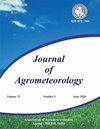Prediction of potato late blight disease incidence based on weather variables using statistical and machine learning models: A case study from West Bengal
Q3 Agricultural and Biological Sciences
引用次数: 0
Abstract
Late blight is one of the most devastating diseases on potato the world over, including West Bengal, India. The economic and yield losses from outbreaks of potato late blight can be huge. In this article, application of statistical models such as autoregressive integrated moving average (ARIMA), autoregressive integrated moving average with exogenous variables (ARIMAX) in combination with machine learning models such as, neural network auto regression (NNAR), support vector regression (SVR) and classification and regression tree (CART) have been explored to predict the percentage disease index (PDI) of potato late blight in the northern part of West Bengal. Models were developed to predict PDI at 3- and 7-days interval using the weather variables viz., rainfall, maximum and minimum temperature, maximum and minimum relative humidity, and dew point temperature. Among the developed models, CART to predict PDI at 7 days interval was found to be the best fitted model on the basis of least RMSE, MAE and MAPE. The results of decision tree (CART) model showed that dew point temperature had a significant effect on PDI at 7 days interval and the incidence of potato late blight was high when dew point temperature was greater than 12 0C in the preceding week.利用统计和机器学习模型,根据天气变量预测马铃薯晚疫病发病率:西孟加拉邦案例研究
马铃薯晚疫病是对包括印度西孟加拉邦在内的全世界马铃薯最具破坏性的病害之一。马铃薯晚疫病的爆发会造成巨大的经济和产量损失。本文探讨了自回归综合移动平均(ARIMA)、带外生变量的自回归综合移动平均(ARIMAX)等统计模型与神经网络自动回归(NNAR)、支持向量回归(SVR)和分类回归树(CART)等机器学习模型的结合应用,以预测西孟加拉邦北部马铃薯晚疫病的百分比病害指数(PDI)。利用降雨量、最高和最低温度、最高和最低相对湿度以及露点温度等天气变量,建立了预测 3 天和 7 天间隔期 PDI 的模型。在所开发的模型中,根据最小均方根误差(RMSE)、最大均方根误差(MAE)和平均均方根误差(MAPE),预测间隔 7 天的 PDI 的 CART 模型被认为是最合适的模型。决策树(CART)模型的结果表明,露点温度对 7 天间隔的 PDI 有显著影响,当前一周的露点温度大于 12 0C 时,马铃薯晚疫病的发病率较高。
本文章由计算机程序翻译,如有差异,请以英文原文为准。
求助全文
约1分钟内获得全文
求助全文
来源期刊

Journal of Agrometeorology
农林科学-农艺学
CiteScore
1.40
自引率
0.00%
发文量
95
审稿时长
>12 weeks
期刊介绍:
The Journal of Agrometeorology (ISSN 0972-1665) , is a quarterly publication of Association of Agrometeorologists appearing in March, June, September and December. Since its beginning in 1999 till 2016, it was a half yearly publication appearing in June and December. In addition to regular issues, Association also brings out the special issues of the journal covering selected papers presented in seminar symposia organized by the Association.
 求助内容:
求助内容: 应助结果提醒方式:
应助结果提醒方式:


